TaPRK
General
Projects
Shows
Excursions
Links
Yleistä
Ratoja
Projektit
Näyttelyt
Retket
Linkit
Parish/SRK
Tapiola Parish Model Railway ClubFREMO N Frankfurt-Nied, 8th March, 2008 |
|---|
|
Unlike the NCI standard so stronly advertised in Finland in a FREMO-treff the trains are not run like in a merry-go-around. Here trains go from one station to another according to a timetable.
FREMO-treffs are not public shows -- instead the modellers have together booked the room and assemble the layout and run it for themselves. hence e.g. the turnout controls are on the front side of the layout. Usually Friday is for setting up and Saturday and Sunday are for operation and after operation the layout is dismantled and modules are taken back home. Often a FREMO treff takes place during "long weekends" so that more operating time vs. setting up time is gained. FREMO e.V. supports FREMO-treffs by funding some or all of the rent of the space. This FREMO-treff was a rehersal to some of the modules in preparation of a bigger meeting (FREMO N has an anniversary). Therefore the layout has more fiddle yards that usual. Before operation starts, the wagons, wagon cards and waybills are distributed around the layout according to plan. Each wagon has a wagon card that describes the details of the wagon and the types of loads it can carry and the owner of the wagon. At the initial setup some of the wagons are loaded and some unloaded waiting for delivery to be loaded or return to home station. The loco driver carries the cards and waybills along the train. When the train arrives to a station the waybills are changed. Generally "Waybill" systems have double-sided waybills, the other side tells where the load is to picked up and the other side where the load should be shipped. After delivery of the load the waybill is removed and wagon is shipped as empty to home or re-assigned another waybill. Timetable is graphic and the station masters and drivers have timetables. The timetables are run aginst fast time clocks. They are so called "side clocks" that are driven with a common timebase. The timebase is a computer providing quick setting of the clocks, adjustable speed ratio and possibility of halting all the clocks. The speed of the clock is usually slower on first session and faster on later sessions as operation becomes more polished. Apparenty the whole timetable is not run at one go, but a lunch break is held in the middle. Each station has a station master who dispatches the trains based on agreement between him and the station master of the next station. This agreement is done via the phone. By using wireless DECT phones one can have a simple wireless phone network without any connection to real phone network. FREMO layouts use (only?) NMRA-DCC for train control. This makes the station cabling of the stations simple. The cab bus is Digitrax-based Loconet. LocoNet specification is open enough and flexible enough for big layout use. LocoNet bus follows he track and Loconet boxes are fitted along the layout for plugging in the home made FRED controllers. One of the speciality of Loconet is the possibility of asigning the controllers to certain loco so that the driver has no way of accidentally un-assigining the loco. Each station has a dedicated booster so that electrical problems at a certain spot of the layout will not paralyze the whole layout. There were two command stations at the treff: one for assigning the locos to throttles and programming of locos and another for actually running the layout. Note that although the layout is driven with LocoNet, the Lenz booster can still be used if only the copy of DCC signal (pins 1 and 6) from LocoNet is connected to Lenz booster's DCC signal inputs C and D. No other connectios should be made! Only one station had electric turnouts. As turnout operation is done mechanically the stations are mostly very simple electrically! I was present at the treff only at the beginning of the running on Saturday. What struck my eye was that the trains were running smoothly without pickup problems, and that switching is completely possible and practical even in N scale. If the trains would not run smoothly there would be no point in trying to run with timetable!
|

[IMG_2309.jpg] General view,layout size approx 8 x 15 m

[IMG_2313.jpg] Each vagon has a vagon card that contains the particulars of the vagon. Before session the vagons, the vagon cards describing the vagon and e.g. suitable loads, and apppropriate cargo waybills are selected and distributed to layout according to session initialisation plan

[IMG_2314.jpg] Fiddleyard Schattenbach (M. Maleis)
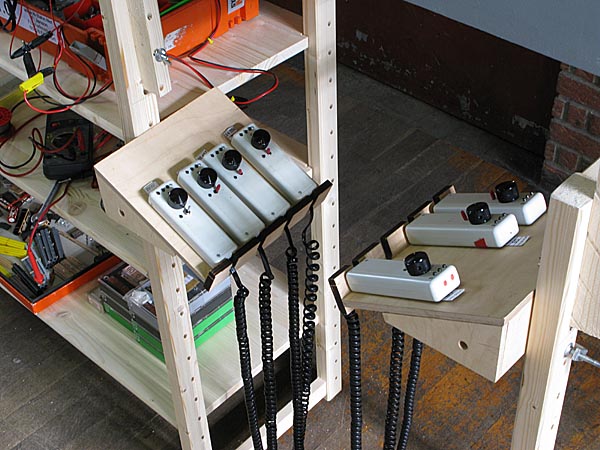
[IMG_2315.jpg] Under the fiddle yard there are stands for FRED controllers of the locos that are currenty on the fiddle yard

[IMG_2316.jpg] Each station has its own booster so that problems at station will not paralyse the whole layout.
Here the "power pack" is a boxed unit that has the (Conrad) transformer and Lenz booster (Note: even though the FREMO layouts are driven with LocoNet bus the boosters are independent of the bus protocol provided only the copy of DCC signal is connected from LocoNet to booster.

[IMG_2317.jpg] FRED controllers under the Schattenbach fiddle yard.
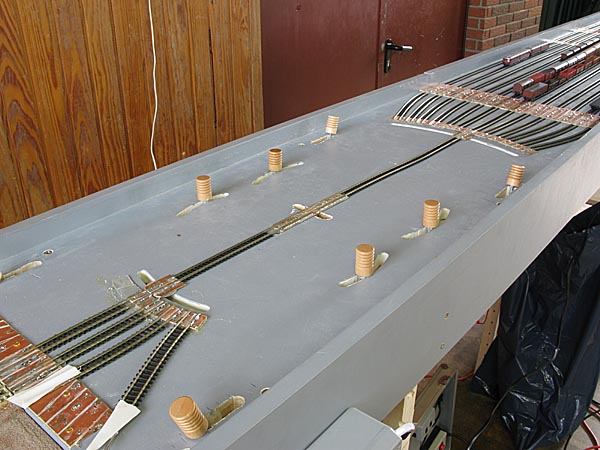
[IMG_2318.jpg] Sector or selector turnouts (Schleppweiche) at Schattenbach fiddle yard. See the video at the bottom of page...

[IMG_2322.jpg] Selector turnout mechanics from below...

[IMG_2323.jpg] Selector turnout mechanics from below...

[IMG_2325.jpg] There were two DCC systems at the treff, this one is for testing and programming the locos and FRED controllers...

[IMG_2327.jpg] ... and this was used to actually operate the layout.

[IMG_2328.jpg] Other end of the fiddle yard Schattenbach had moveable section of track that was used to move the locos from one end of the train to another. Alignment and power feed is clearly visible.

[IMG_2330.jpg] I have always been sceptical about alignment of double track modules (Tapiola club's Kauniainen layout has proved the fears to be real!) apparently there was no problem here....

[IMG_2331.jpg] The filing of the end of the rails is often exaggarated in Finnish FREMO modules. here is a sample of cutting the corners...

[IMG_2332.jpg] Different chemichals have been sed for cleaning the track. here is one example.

[IMG_2333.jpg] Wagon cards are placed close to wagons at the Tettnang yard (K. Rilling)...

[IMG_2334.jpg] Here a closeup of a wagon and card.

[IMG_2335.jpg] Station Tettnang had also a dedicated booster, here connected as the last unit of the LocoNet bus...

[IMG_2336.jpg] Another view of fiddle yard Schattenbach and the selector turnouts...

[IMG_2337.jpg] Double track modules #3# have aluminium legs

[IMG_2338.jpg] Double track part of the layout...

[IMG_2339.jpg] Chemie Anlagen Bau AG, a double track section with spurs...

[IMG_2340.jpg] The arrangement of the spurs is such that one needs to travel in "wrong" direction to gain access to one of the spurs, this creates interesting and challencing operation...

[IMG_2341.jpg]A small desk attached to the side of the layout, below a collection of waybills...

[IMG_2342.jpg] Turnout controls the simplest form...

[IMG_2344.jpg] Under the layout a SPST switch is enough to switch the polarity of the turnout crossing. White piece of plywood protects the mechanism during assembly of the layout as the turnout is close to the end of the module....

[IMG_2345.jpg] ...

[IMG_2347.jpg] ...

[IMG_2348.jpg] Here a nice bridge on'Joschidul' "Bridge" module (H.Reinl)...

[IMG_2349.jpg] Here one can see how land often slopes down near a river, so while making a bridge module one should not just cut a groove into a flat module.
The Bridge module is in fact not a FREMO module but a 'Joschidul'. It is narrower that the FREMO-module, and was built using Minitrix track.

[IMG_2350.jpg] Lively scene at the riverside...

[IMG_2351.jpg] I used a borrowed camera and was not quite sure about the settings...

[IMG_2352.jpg] Station Emondsfeld (not yet finished). The difference between 'Bridge' Joshmodule and Emondsfeld FREMO module is clear....

[IMG_2354.jpg] Here are the locos circulation lists

[IMG_2355.jpg] LocoNet-box, a key feature of a FREMO layout DCC system. The box has four RJ connector in parallel, the connectors at the side are for chaining the boxes and the connectors at he front for connecting the FRED throttles...

[IMG_2356.jpg]Fiddle yard Boxenem. the cassettes can rotate whole short trains...

[IMG_2357.jpg] Station Tettnang is under construction...

[IMG_2358.jpg] Tettnang...

[IMG_2359.jpg] Module joints are causing a lot of problems in Finland -- hence I've photographed the joints...

[IMG_2360.jpg] Flatness is one of the most challenching things in building a layout.

[IMG_2361.jpg] ...

[IMG_2362.jpg] Station Hauketal (J. Schmidt) has interesting legs: the protective covers of the modules serve as legs

[IMG_2363.jpg] Closeup of turnout controls and a Loconet-box...

[IMG_2364.jpg] Another example of turnout linkage under station Tettnang...

[IMG_2365.jpg] ...

[IMG_2366.jpg] Station Hauketal legs...

[IMG_2367.jpg] Station Hauketal has had laid track on 9 mm and 6.5 mm gauge (normal and narrow gauge)

[IMG_2368.jpg] ...

[IMG_2369.jpg] Hauketal was one of the only station on the layout with electric point motors. Here are the controls of the station...

[IMG_2370.jpg] Hauketal...

[IMG_2371.jpg] Hauketal had Viessman signals as home signals...

[IMG_2377.jpg] Station Fördertechnik ...

[IMG_2378.jpg] Great scenery on 'Joschidul' Bauernhof farm (H.Reinl)

[IMG_2379.jpg] ...

[IMG_2380.jpg] Module Sickte
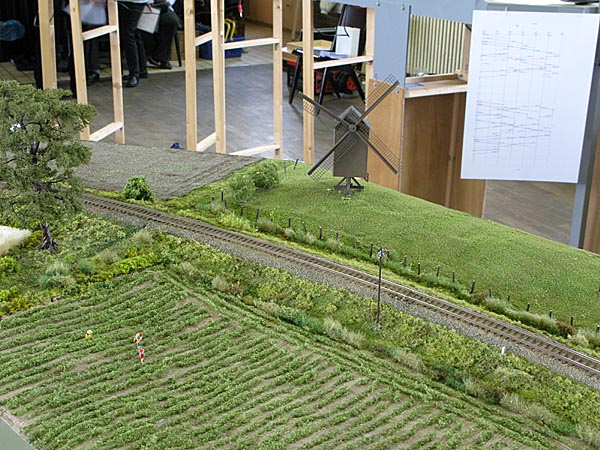
[IMG_2381.jpg] ...

[IMG_2382.jpg] ...
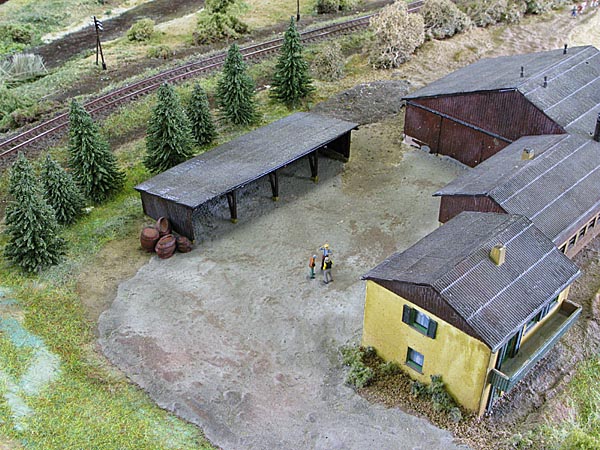
[IMG_2383.jpg] Module Bauernhof farm

[IMG_2384.jpg] Fast time clock timebase...

[IMG_2385.jpg] Industrial area "Sägewerk Maleis" (M. Maleis)
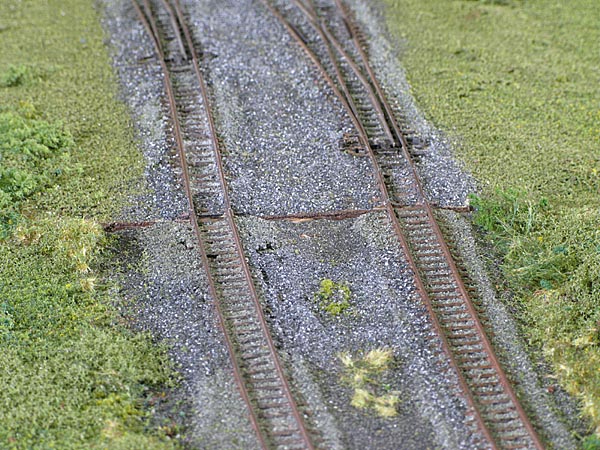
[IMG_2386.jpg] ...

[IMG_2387.jpg] ...

[IMG_2388.jpg] Open mine "Reiters hausen" for sand stone and granite to provide two types of wagon loads...

[IMG_2389.jpg] "Sägewerk Maleis" turnout controls

[IMG_2390.jpg] ...

[IMG_2391.jpg] ...

[IMG_2392.jpg] Spares...

[IMG_2393.jpg] Here the connectors for power. the fmale connectors in the middle module are nicely attached to the frame and the male connectors have fly leads...

[IMG_2394.jpg] Another method of attaching the female connectors (Hauketal, J. Schmidt) ...

[IMG_2399.jpg] "Reiters hausen" at the background
|
Video clips
Dispatching.WMV [1.6+MB] |
|
Links to other pages of the Frankfurt Nied treff
N-RE-Treffen in Frankfurt-Nied 07.-09.03.2008 (official site) [M.Gruß] |
29778 kävijää/visitors
© 1996-2023 Tapiola Parish Model Railway Club / Tapiolan seurakunnan pienoisrautatiekerho, Viimeksi päivitetty / last modified (none). Created with Notepad.
Text, drawings and photos are protected by copyright laws. Technical solutions, methods and source code are public domain only for non commercial purpose. All development has been carried out during our free time, mainly funded from our own pocket and with non selfish goals, so the use of this material for profitable use (including construction for a friend aginst a fee) is forbidden without written permit from the club. The pages contain errors, so, if you use the data given, you do so at your own risk and responsibility. If you further develop material found on these pages you must put it on display without fee e.g. to a freely available web page. We expect a note about this also.
Pages tested with W3C validator -- didn't look good ;)
[YHTEYSTIEDOT] Älä lähetä sähköpostia!
Tekstit, kuvat ja piirokset ovat tekijänoikeuslain suojaamia. Tekniset ratkaisut, menetelmät ja lähdekoodit ovat vapaasti kopioitavissa ja hyödynnettävissä ei-kaupallisissa tarkoituksissa. Kaikki kehitystyö on tehty vapaa-aikana ja pääosin henkilökohtaisilla varoilla eikä hyötymistarkoituksessa, siksi materiaalin käyttö hyötymistarkoituksiin (sisältäen kaverille rahasta rakentamisen!) on kielletty ilman kerhon kirjallista lupaa! Sivuilla esiintyy virheitä. Jos käytät sivujen tietoja hyväksesi, teet sen täysin omalla vastuullasi. Mikäli kehität sivuilla esiettyjä ajatuksia kytkentäkaavioita tai koodia edelleen, on sinun asetettava se maksutta kaikkien saataville esimerkiksi Internetiin. Odotamme vastavuoroisesti tietoa suoritetusta edelleenkehitystyöstä.
Sivut testattu W3C validatorilla -- ei näyttänyt hyvältä ;)